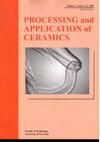氧化锆-氧化钇-二氧化钛陶瓷的室温塑性:实验指示和结构建模
IF 0.8
4区 材料科学
Q3 MATERIALS SCIENCE, CERAMICS
引用次数: 0
摘要
氧化钇稳定的四方氧化锆(Y-TZP)陶瓷具有优异的力学性能。然而,由于这些材料的高硬度和脆性值,在室温下不能发生塑性变形,阻碍了可加工性。为了克服这些限制,我们提出了一种氧化锆-钇-钛陶瓷,基于氧化锆含有3mol%的钇和高达15mol%的钛。采用共沉淀法合成了氧化锆-氧化钇-二氧化钛粉体,并在1400℃下进行单轴压制和烧结。通过x射线衍射、扫描电镜对样品进行表征,并通过维氏硬度和韧性测量对样品进行力学性能表征。与Y-TZP陶瓷相比,共掺10mol%Ti的氧化钇稳定四边形氧化锆陶瓷的四边形参数明显增加,韧性提高,硬度值降低,显示出室温塑性。此外,密度泛函理论方法的原子模拟表明原子的空间排列的发生,解释了所提出的可塑性。本文章由计算机程序翻译,如有差异,请以英文原文为准。
Room temperature plasticity of zirconia-yttria-titania ceramics: Experimental indications and structural modelling
Yttria-stabilized tetragonal zirconia (Y-TZP) ceramics have excellent mechanical properties. However, such materials cannot undergo plastic deformation at room temperature due to their high hardness and brittleness values, hindering machinability. To overcome these limitations, we propose a zirconia-yttria-titania ceramics, based on zirconia containing 3mol% yttria and up to 15mol% titania. The zirconia-yttria-titania powders were synthesized by co-precipitation method, uniaxially pressed and sintered at 1400?C/5 h. Sample characterizations were carried out by X-ray diffraction, scanning electron microscopy and mechanical properties through Vickers hardness and toughness measurements. Compared to the Y-TZP ceramics, the yttria stabilised tetragonal zirconia ceramics co-doped with 10mol%Ti showed noticeable increase of tetragonality parameter, higher toughness and lower hardness values, indicating plasticity at room temperature. Furthermore, the atomistic simulation by Density Functional Theory methodology suggests the occurrence of spatial arrangement of the atoms, explaining the proposed plasticity.
求助全文
通过发布文献求助,成功后即可免费获取论文全文。
去求助
来源期刊

Processing and Application of Ceramics
MATERIALS SCIENCE, CERAMICS-
CiteScore
1.90
自引率
9.10%
发文量
14
审稿时长
10 weeks
期刊介绍:
Information not localized
 求助内容:
求助内容: 应助结果提醒方式:
应助结果提醒方式:


